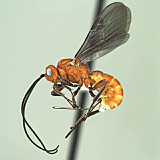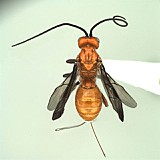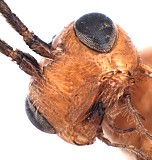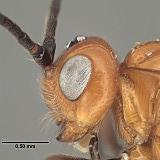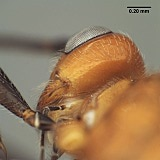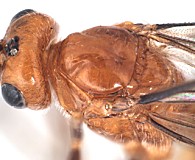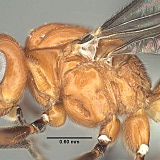Diachasmimorpha sanguinea (Ashmead, 1889)
Remarks
See comments under the Diachasmimorpha page.
Taxonomic History / Nomenclature
Phaedrotoma (?) sanguinea Ashmead, 1889: 655. Holotype female in USNM. Marshall 1891: 47 (relationship to a European species of Opius).
Opius sanguineus: Gahan 1915: 69, 74 (key, synonymy, expanded distribution and host); Muesebeck and Walkley 1951: 157 (synonymy, new distribution and host); Muesebeck 1967: 54 (catalog).
Opius (Biosteres) sanguineus: Fischer 1965: 116, 138-139 (key, redescription).
Biosteres sanguineus: Fischer 1971: 30 (catalog, change in rank); Wharton and Marsh 1978: 152, 156 (key, diagnosis, distribution, biology); Marsh 1979: 201 (catalog).
Biosteres (Chilotrichia) sanguineus: Fischer 1977: 804, 819-821 (key, redescription).
Diachasmimorpha sanguinea: Wharton 1997: 14 (generic transfer).
Opius sanguineus: Gahan 1915: 69, 74 (key, synonymy, expanded distribution and host); Muesebeck and Walkley 1951: 157 (synonymy, new distribution and host); Muesebeck 1967: 54 (catalog).
Opius (Biosteres) sanguineus: Fischer 1965: 116, 138-139 (key, redescription).
Biosteres sanguineus: Fischer 1971: 30 (catalog, change in rank); Wharton and Marsh 1978: 152, 156 (key, diagnosis, distribution, biology); Marsh 1979: 201 (catalog).
Biosteres (Chilotrichia) sanguineus: Fischer 1977: 804, 819-821 (key, redescription).
Diachasmimorpha sanguinea: Wharton 1997: 14 (generic transfer).
In publications prior to about 1988, the species of Diachasmimorpha were placed either in the genus Opius or in the genus Biosteres. This species, however, was not formally transferred to Diachasmimorpha until 1997 (Wharton 1997).
Diagnosis and Relationships
Diachasmimorpha sanguinea is nearly identical to Diachasmimorpha mexicana, and both of these species differ in coloration from Diachasmimorpha hildagensis and similar dark-headed species. All of these New World species have relatively weakly developed notauli and a straight ovipositor (not apically sinuate as in longicaudata and related Indo-Pacific species). The occipital carina is also very short to nearly absent and hypopygium uncharacteristically shortened (relative to most of the Old World species). Diachasmimorpha sanguinea is more heavily sculptured than Diachasmimorpha mexicana, best evident in the sculpture of the precoxal sulcus which is nearly smooth in Diachasmimorpha mexicana.
Distribution
Nearctic: Maryland to Florida and west to Missouri and Arizona (Wharton and Marsh 1978).
Distribution
Biology / Hosts
Zonosemata electa (Say) and Z. vittigera (Coquillett).
This species was originally described from several specimens reared from Zonosemata electa infesting fruits of Solanum carolinense L. (Ashmead, 1889, Gahan 1915). The only known host of Zonosemata vittigera is Solanum eleagnifolium Cav. (Foote et al. 1993) and this is the host plant from which we have reared Diachasmimorpha sanguinea in central and western Texas.

